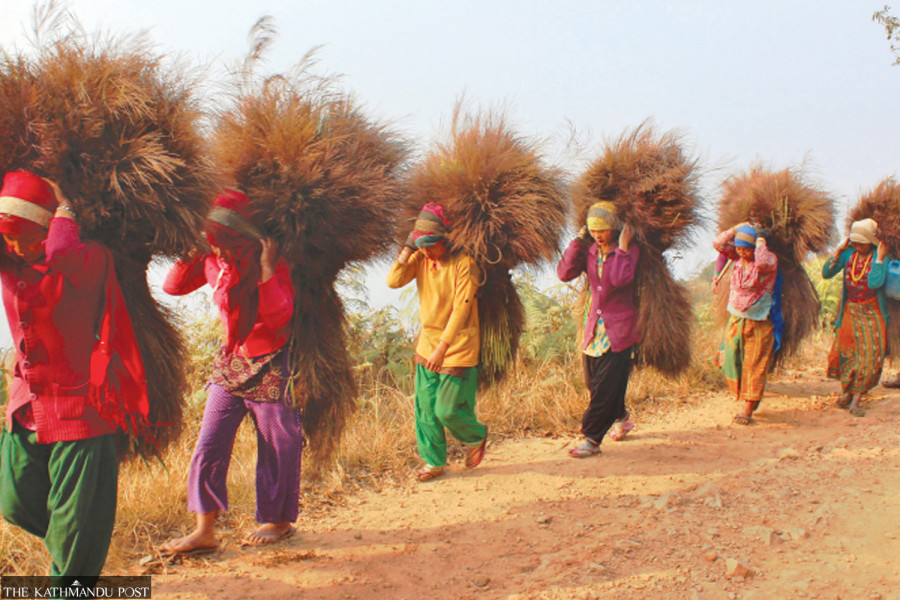Money
Jobs being created in Nepal lack quality: Experts
Each year, about 900,000 Nepali youths leave the country as migrant workers and students. The figure reflects that the quality and quantity of jobs created in Nepal do not meet the needs and aspirations of the youth.
Krishana Prasain
While overall unemployment rates are low, the jobs being created in Nepal’s economy are not quality jobs, analysts said on Friday, stressing the need for new strategies, new partners and new goals.
The quality and quantity of jobs created in Nepal do not meet the needs and aspirations of the youth, forcing them to try their luck abroad, said Danielle Meuwly, ambassador of Switzerland to Nepal, speaking in a panel discussion entitled “Unlocking the Potential of Job Creation in Nepal: What Would It Take?”
“It is important to think about what kinds of jobs Nepal needs in its transformational journey as Nepal is set to graduate from the least developed countries (LDCs) by 2026.”
“Each year, about 900,000 Nepali youths leave the country as migrant workers and students,” Meuwly said. “The figure reflects that the quality and quantity of jobs created in Nepal do not meet the needs and aspirations of the youth.”
Participants said that to create quality jobs, Nepal needs investment.
Nepal has to position itself as the best-performing and most productive economy in the region, said Meuwly.
“Small and medium enterprises (SMEs) account for a quarter of the GDP in Nepal and employ about 1.7 million people. Only 18 percent of formal SMEs employ more than 20 persons.”
There are three bottlenecks for the growth of SMEs in Nepal, according to Meuwly.
First, there is a lack of access to growth capital as commercial banks think it is risky to invest in SMEs. Second, lack of business development services which includes technical knowledge.
Third, poor access to human resources as Nepal’s education sector does not prepare the human resources required for the labour market.
“Nepal needs to make reforms in these sectors,” said Meuwly.
According to the World Bank’s recent report on Jobs for Resilience, during the 2010s, Nepal’s small non-agriculture sector struggled to absorb an influx of labour from rural areas to the cities.
This was accompanied by considerable emigration. A subsequent surge in working-age population growth, fueled by return migration from Gulf countries during the pandemic, compounded employment losses during 2020–23.
As a result, Nepal’s employment ratio declined by 11 percentage points during 2000–2023.
The report said that men’s employment ratios declined in Bangladesh, Bhutan, India, Maldives, and Nepal, by less than 1 percentage point in Bangladesh and more than 9 percentage points in Bhutan, India, and Nepal.
In all South Asian countries except Sri Lanka, declines in employment ratios have been steeper (Bangladesh, Bhutan, India, Maldives, Nepal), or increases smaller (Pakistan), for men than for women.
“We need an inclusive economy. Women have always been in the informal sector and are not counted in the national economy. The challenges are women have limited skills and low wages at all levels,” said Pramila Acharya Rijal, president of the South Asian Women Development Forum.
The government has drafted micro, cottage, and small-scale enterprise promotion policies to integrate the informal sector into the formal market. “We hope this policy will come into effect soon as a large number of women are engaged in micro, cottage and small enterprises,” Rijal said.
“The government's policy is to focus on production and productivity, as well as job creation. For that, we need to boost the private sector's confidence as the public sector has limited impact on overall employment generation,” said Ram Prasad Ghimire, revenue secretary at the Ministry of Finance.
“We need to enhance public sector investment with the help of development partners so that it encourages private sector investment,” Ghimire said.
Former Finance Minister Yuba Raj Khatiwada said, “For Nepal, it’s not an issue of jobless growth. It’s an issue of low growth.”
“Jobs are a secondary element because even if we create jobs in the country, we are not able to protect the jobs for Nepalis.”
In many countries, we see a shift from agriculture to manufacturing and services, but that did not happen in Nepal, Khatiwada said. “People left agriculture and they didn’t have anywhere else to go,” he said.
“In the past, the government introduced an employment guarantee programme to secure jobs for people along with promoting growth and national infrastructure. But we don’t know what happened to that,” Khatiwada said.
Khatiwada said lots of reforms are required in Labour and Procurement laws and other policies of the government to see that growth surpasses 5 percent and jobs grow at the same rate.
The World Bank said that employment ratios fell in Bhutan, India, Maldives, and Nepal, while in Bangladesh, Pakistan, and Sri Lanka, they rose at half the pace that the Republic of Korea achieved in the 1960s and 1970s.
As a result of this employment weakness, more than two-thirds of South Asia’s output growth since 2000 has been accounted for by labour productivity growth and the remainder by working-age population growth, while the declining employment ratio reduced growth.
Overall, during the period 2010–2023, net migration from South Asia represented a loss of about 2 percent of the region’s working-age population, the World Bank said. “Large-scale emigration may in part reflect poor job prospects.”




 14.12°C Kathmandu
14.12°C Kathmandu















